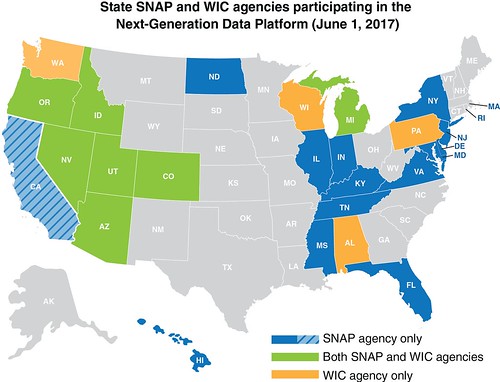
Who participates in federal food assistance programs, and how does participation affect their lives? Who doesn’t participate, and why not? Policymakers need high-quality data on such questions to make informed decisions about these programs, which affect millions of lives each year. That is why two USDA agencies are collaborating with the U.S. Census Bureau to produce research that sheds new light on the programs.
The strategic partnership among USDA’s Economic Research Service (ERS), the USDA Food and Nutrition Service (FNS), and the Census Bureau brings each agency’s expertise to the effort. ERS is USDA’s principal social science research agency, while FNS administers USDA’s Supplemental Nutrition Assistance Program (SNAP) – which serves about 42 million people a year, and the Special Supplemental Nutrition Program for Women, Infants, and Children (WIC) – in which about 7.2 million people participate. The Census Bureau not only conducts the nation’s decennial census, but is the leading source of quality data about the U.S. people and economy.
The three-way collaboration, known as the Next-Generation Data Platform, combines USDA administrative data with survey and administrative data from other government programs to provide a more complete picture of the SNAP and WIC programs. It is yielding findings that would otherwise be impossible to obtain.
For example, ERS researchers used the Next-Generation Data platform to link two data sources to estimate the SNAP Access Rate - that is, the share of eligible people who participate in SNAP within small geographic areas (such as counties) and for certain demographic groups (such as race/ethnicity, household type, and veteran status). The SNAP administrative data helps to identify the number of participants, while the Census Bureau’s American Community Survey data on income, citizenship, and household composition helps to estimate how many people are eligible to participate in a particular area.
You can view an interactive visualization of these rates for New York. Three reports, SNAP Access at the State and County Levels: Evidence from Texas SNAP Administrative Records and the American Community Survey, Annual and Monthly SNAP Participation Rates, and Improving the Assessment of SNAP Targeting Using Administrative Records, provide additional detail on some of the findings that have already come out of this project.
The partnership between USDA and the Census Bureau is a long-term effort to acquire State-level data for SNAP and WIC, which will continue to inform the research. The individual records in a State’s dataset can be linked in a secure data environment, protecting confidentiality, to matching records in government surveys or in administrative data from other government programs.
As States have learned about the project and have seen the value of data sharing, more States have provided their data to the project. In mid-year of 2017, 20 State SNAP agencies (including some of the counties in California) and 11 State WIC agencies were partners in the Next-Generation Data Platform.
Research based on this collaborative data-linking effort will continue to produce findings that inform policymakers and the American public.

